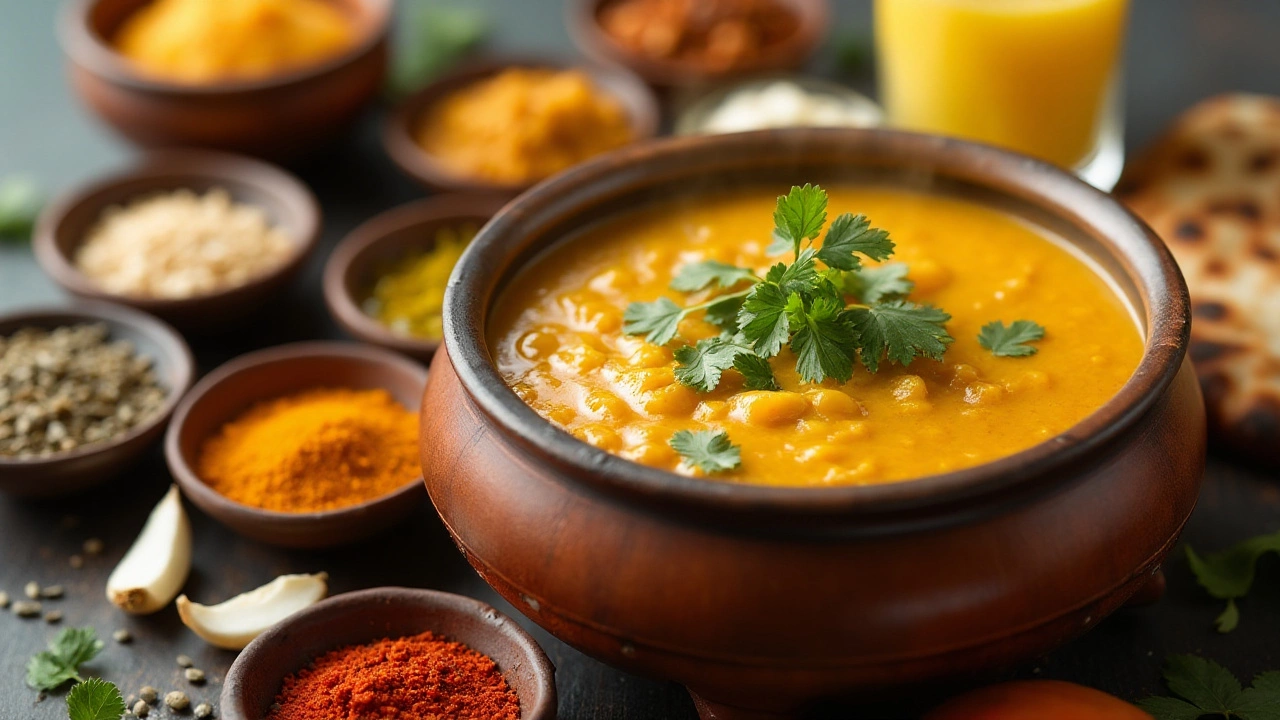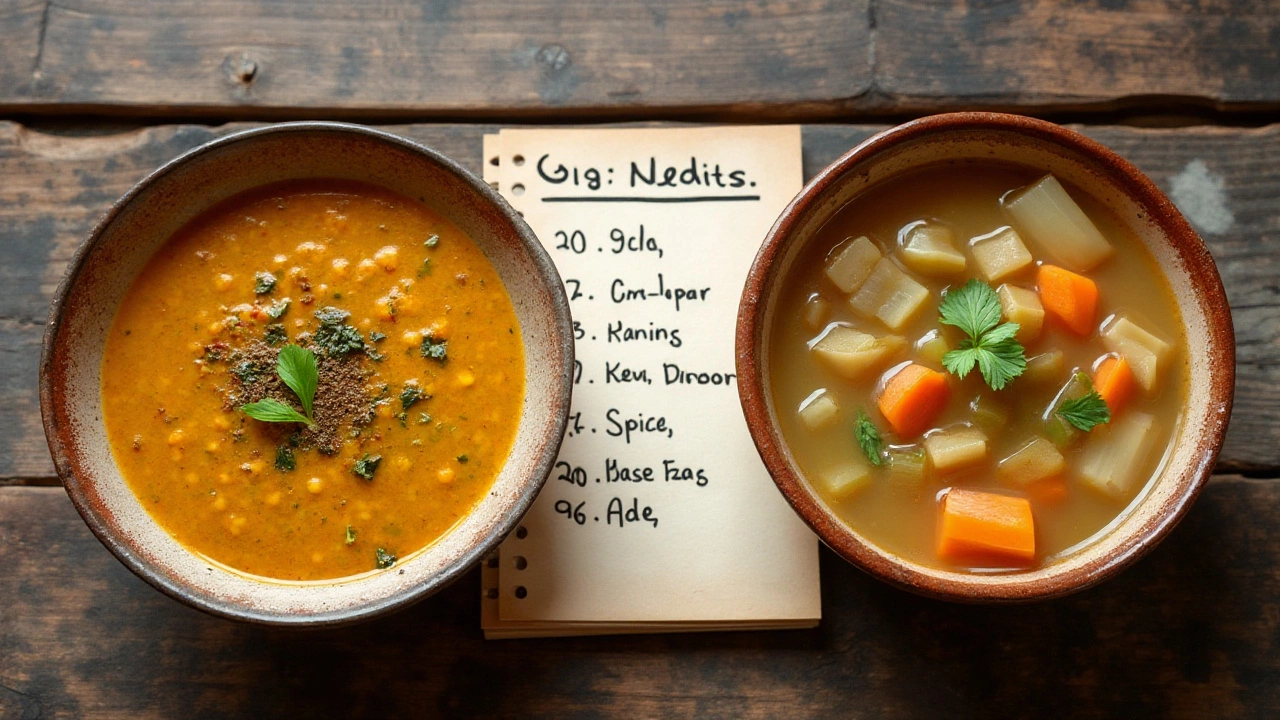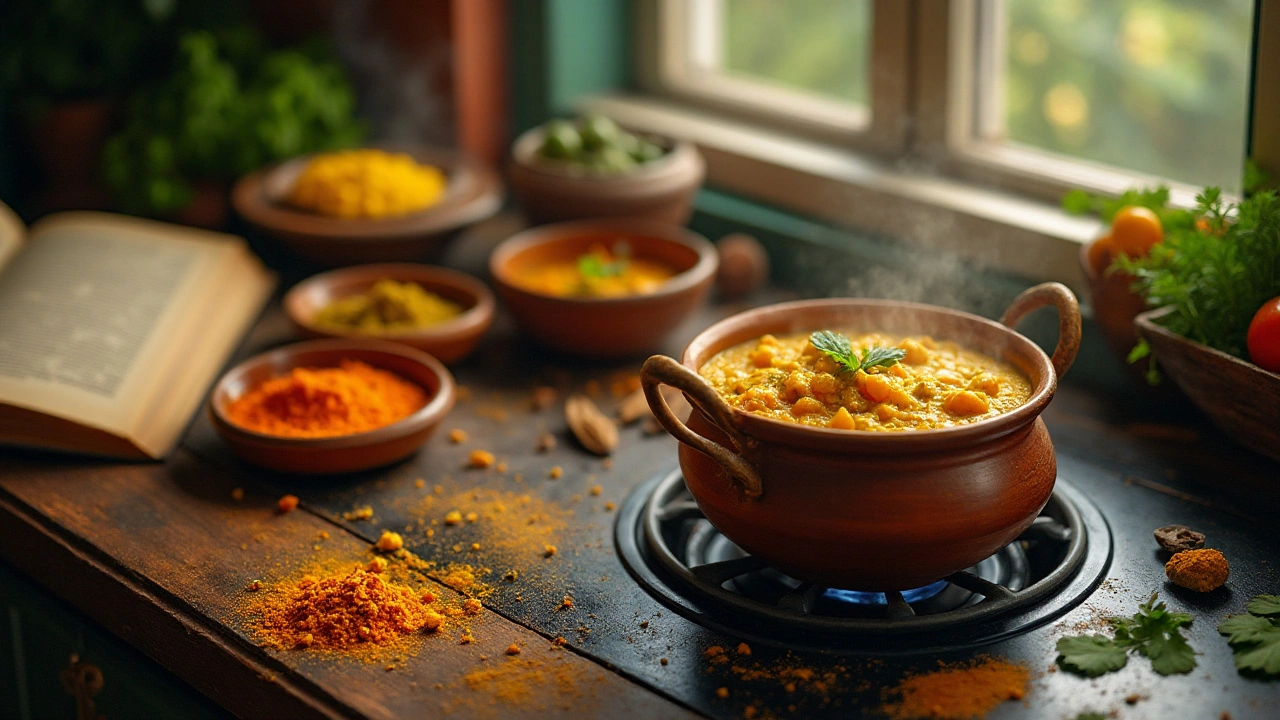Dal is a little pot of sunshine, the kind that warms you from the inside out. This simple yet profound dish has long been a cherished staple in Indian homes, passed down through generations not just as a meal, but as a tradition.
When you look across the culinary landscape, you'll find that each culture has embraced legumes in its own unique way. In English-speaking countries, the closest equivalent to dal might be a hearty lentil soup or stew. These dishes share a comforting earthiness and offer a similar homely warmth.
In this article, we'll peel back the layers of flavors and traditions to explore what makes dal so special, and how it translates into Western cuisines. Alongside, you'll discover a few simple recipes that capture the essence of dal, allowing you to bring this delightful dish onto your own table, no matter where you are in the world.
- Understanding Dal and Its Variants
- Dal's Nutritional Value
- The Western Lentil Connection
- Simple English Variations of Dal
- Tips for Cooking Perfect Dal
- Serving Suggestions and Pairings
Understanding Dal and Its Variants
Dal, often celebrated as the backbone of Indian cuisine, is more than just a dish; it is an entire culinary philosophy. At its core, dal refers to dried, split pulses that do not require soaking before cooking. These pulses include lentils, peas, and various types of beans. In India, dal is synonymous with comfort food, often forming the heart of simple yet satisfying meals. The appeal of dal lies in its ability to adapt and complement a variety of flavors, making it a versatile dish suited for every palate and occasion.
The diversity within dal is as vibrant as the regions of India where it is cooked. Each state's culinary landscape adds a distinctive twist to their dal preparations. For instance, Masoor dal, made from red lentils, is immensely popular in Northern India. Meanwhile, the Southern regions might indulge in Sambar, which marries their spices with a medley of vegetables to create a tangy, aromatic experience. These dishes demonstrate the adaptability of dal to local taste preferences and available ingredients. Such dishes not only nourish but also tell a tale of cultural heritage and community.
Even the most basic forms of dal carry unique identities. The traditional Tadka Dal, where spices are sautéed in ghee or oil and then added to the cooked dal, creates an aromatic zest that elevates the dish's simplicity. This practice of 'tadka' or tempering is a fundamental technique that imparts a smokey depth of flavor. In Bengal, the earthy Moong Dal is revered, often dry-roasted for a nutty richness before being transformed into a warm, buttery soup. Each variant brings something quintessentially Indian to the table, featuring a spectrum of flavors that range from mild and creamy to vibrantly spicy.
Dal's significance isn't merely limited to taste or tradition; it stands as a pillar of nutrition. Pulses used in dal are an excellent source of plant-based protein, fiber, and essential nutrients, making it an indispensable part of a vegetarian diet. The dietary fiber in them helps maintain a healthy digestive system, while their low glycemic index is particularly beneficial for controlling blood sugar levels in diabetics. Nutritional data supports dal's health benefits, showing these dishes as effective in promoting satiety and helping manage weight. The focus on dal in everyday diets reflects an ancient understanding of balanced nutrition that modern science continues to advocate.
The intrigue of dal isn't confined to Indian kitchens. Western cuisines have embraced these pulses in nuanced forms. English lentil soup emerges as a direct counterpart to Indian dal, often enriched with similar warm spices but adapted to Western palates through the inclusion of local herbs like thyme or sage. This adaptation highlights the global resonance of dal, offering endless possibilities for fusion dishes that marry Indian and Western flavors harmoniously. As food enthusiasts continue to explore cross-cultural culinary experiences, dal remains a bridge connecting diverse gastronomy journeys, embodying the universality of comfort food.
"Dal has been an integral part of our diet for ages, a respect for simplicity, and a celebration of variety," writes culinary historian Anita Sharma, whose works explore traditional Indian cooking.
Dal's Nutritional Value
Dal, a cornerstone of Indian cuisine, is more than just a comfort food; it's a powerhouse of nutrients essential for maintaining good health. This humble dish primarily consists of lentils or other legumes such as chickpeas and pigeon peas, contributing significantly to its nutritional profile. These ingredients are packed with plant-based protein, making dal an excellent dietary choice for vegetarians and vegans alike, providing the necessary amino acids that are the building blocks of protein. The protein content not only helps build and repair tissues but also supports immune function and muscle strength.
Beyond protein, dal is rich in dietary fiber, which plays a crucial role in promoting digestive health. Consuming fiber helps regulate bowel movements, lowers cholesterol levels, and contributes to a feeling of fullness, which can aid in weight management. Lentils are a superb source of soluble fiber, which dissolve in water to form a gel-like substance in the gut, thus slowing digestion and stabilizing blood sugar levels. Meanwhile, the insoluble fiber bolsters gut health by adding bulk to stool, facilitating smoother digestion.
Lentils in dal also boast an array of vitamins and minerals. They're particularly high in B vitamins such as folate and niacin. Folate is essential for DNA synthesis and repair, making it crucial for pregnant women to support fetal development and decrease the risk of neural tube defects. Niacin, on the other hand, aids in energy production and the maintenance of healthy skin. Additionally, dal provides vital minerals like iron, magnesium, and zinc. Iron is indispensable for transporting oxygen in the blood, while magnesium supports muscle and nerve function. Zinc plays a significant role in bolstering the immune system. As these nutrients are often less prevalent in the standard diet, dal can help fill these nutritional gaps and contribute to robust health.
"Eating a diet rich in pulses can significantly lower not just cholesterol levels, but also help in reducing the risk of chronic diseases," Dr. Mark Hyman, a leading advocate of Functional Medicine, once noted about the impact of such nutrients.
For folks concerned with glycemic index, lentils have a low impact on blood sugar, another feather in dal's cap when considering managing diabetes or preventing its onset. A steady inclusion of low glycemic foods helps maintain balanced energy levels over time, steering clear of sugar spikes and crashes that could compromise health. Meanwhile, dal dishes can be remarkably low in fat, especially when prepared without added oils and creams, highlighting their heart-friendly nature. These characteristics make dal an outstanding inclusion in diets targeting cardiovascular health. With such an impressive nutritional lineup, it's no wonder that dal is a cherished, soul-nourishing dish across India and increasingly celebrated worldwide as part of a wholesome, balanced diet.

The Western Lentil Connection
When it comes to comforting dishes in Western cuisine, lentil-based creations often take center stage, much like dal does in Indian households. Lentils, with their mild nutty flavor and versatility, have found their way into numerous recipes that mirror the straightforward yet impactful approach of dal. From hearty lentil soups simmering on a cold winter day to rich and savory stews packed with vegetables and herbs, the connection between these two culinary worlds becomes delightfully apparent. Historically, lentils have been a staple in many European diets due to their ease of storage and high nutritional value. This aligns perfectly with the essence of dal, which has sustained millions over centuries with its simple goodness and ease of preparation.
One fascinating aspect of this connection is the historical role lentils have played within various Western cultures. Not only were they used in ancient Greece as a primary source of protein, but they were also highly regarded in Mediterranean regions. In modern times, lentil soup recipes have become synonymous with comfort food in many English-speaking countries, offering a soul-satisfying experience similar to enjoying a warm bowl of dal.
"The lentil is a total protein package, providing unique flavors and health benefits," says renowned nutritionist Dr. Jane Robson."Understanding this connection enriches the culinary experience, offering a sense of familiarity while introducing a cross-cultural flair to home cooking.
Additionally, cultural interpretations of lentil dishes have evolved to include various spices and ingredients inspired by global influences. For example, Moroccan lentil soup often incorporates spices like cumin and coriander, and even some chilies, adding an aromatic twist that nods to the spicy complexity of dal. Moreover, variations with additional vegetables or meats, such as the classic European dish, shepherd's stew, further exemplify the adaptation of lentils into various dietary staples. These substitutions and additions expand the recipe possibilities, keeping the dishes fresh and exciting, yet uncomplicated. Thus, the Western lentil connection is not just about shared ingredients; it's a bridge that links diverse cultures through shared appreciation of simplicity and comfort.
Simple English Variations of Dal
For those who are well acquainted with the rich tapestry of Indian cuisine, "dal" exudes more than just nourishment; it’s a flavorful experience. In contrast, English culinary traditions have their own comforting legume-based dishes, but with their own twist. The most direct counterpart would be a robust lentil soup, known for its simplicity and versatility. Lentils are a pantry staple in many households due to their affordability and nutritional benefits. They are rich in protein, fiber, vitamins, and minerals, making them a go-to ingredient for creating hearty meals that satisfy both the soul and the body.
One delightful variation is the classic lentil and vegetable soup. This dish taps into the earthy flavors of legumes, with the added bonus of seasonal vegetables. To start, sauté onions, garlic, carrots, and celery in a generous splash of olive oil until they grow soft and fragrant. Introduce red or green lentils, stirring them gently with the vegetables. To transform this into something reminiscent of dal, add a dash of cumin and a hint of turmeric. These spices not only elevate the flavor but also introduce a golden hue emblematic of its Indian counterpart. Pour in vegetable broth, let it simmer until the lentils are tender, and finish with fresh parsley or cilantro for that vibrancy and freshness.
Another cherished variation would be baked lentil casserole. Combining cooked lentils with a medley of herbs, topped with breadcrumbs and cheese, it makes for a sumptuous meal that echoes the stuffing-like texture loved in English dishes. It bridges traditional comfort foods with the healthy allure of lentils. There’s a profound satisfaction in watching the crust turn golden brown in the oven, almost like replicating the layered textures and flavors found in dal recipes. For those daring enough to fuse elements, try adding a pinch of curry powder to incorporate a fusion of flavors that bring out the essence of dal while keeping it true to the English palate.
The versatility of lentils is astounding. An exciting fact reported by the
Lentil Institute states, "Lentils have been a part of the human diet since aceramic (pottery pre-ceramic) Neolithic times, and they now boast varieties to match nearly every region and cuisine."This historical embrace of lentils sends a comforting message of unity in diversity, proving that from East to West, the humble lentil can bring hearts and bellies together. Embracing simple dal recipes in English cooking blends the richness of cultural traditions with modern-day taste needs. Adding your own touch, be it herbs, spices, or preparation techniques, makes the dish not just food for the body but also a story shared at the dinner table.

Tips for Cooking Perfect Dal
Cooking dal is an art form that delights both the palate and the soul. Although often regarded as a humble dish, its rich flavors and nourishing qualities require some culinary prowess to master. To begin, it's crucial to select the right type of dal. With various options like toor, masoor, moong, and chana, each offers unique textures and flavors. A delicious dal has a creamy consistency that envelops every mouthful, achieved by cooking the lentils to perfection. First, inspect your lentils for debris or stones, then rinse them thoroughly under running water to remove dirt and excess starch.
Simmering is an essential step in unlocking the full potential of dal's flavor. Bring your rinsed lentils to a boil in a pot of water, then let them simmer gently. The gentle bubbling helps break down the lentils, making them soft and creamy. While the dal simmers, you can prepare the tadka—a fragrant blend of spices tempered in hot oil or ghee. It's this tadka, often comprising cumin seeds, mustard seeds, garlic, and curry leaves, that elevates dal to unforgettable heights. Pour it over the cooked dal for an infusion of robust flavor.
"The secret to dal is in the tadka. As the spices crackle in hot ghee, they release aromas that dance over the simmering pot, transforming simple lentils into magic," shares a famous chef from Mumbai.
Patience plays a vital role in achieving the perfect consistency. A longer simmer enhances the flavors and creates a satisfying thickness. As the dal cooks, stir occasionally and monitor the water level to ensure it doesn't dry out or stick. Adding salt during the simmering process can sometimes hinder the softening of the lentils, so consider seasoning it toward the end, when the lentils are nearly tender. This method ensures there's enough time for the salt to incorporate evenly without compromising texture. For those who prefer a smoother dal, a quick whirl with an immersion blender or a potato masher can do wonders.
If you're feeling adventurous, you can experiment with additional ingredients that bring depth and character to your dal. Vegetables such as tomatoes, spinach, or carrots can be introduced to the mix, adding layers of flavor and nutrition. Likewise, incorporating a touch of tamarind pulp or a splash of lemon juice at the end can add a pleasant tanginess. A dollop of yogurt or a spoon of cream can lend a rich finish, creating a luxurious version of the otherwise simple dish. Such creativity in cooking is what keeps the tradition of dal alive, adapting to the times while respecting its roots.
Lastly, don't overlook the small details that can enhance your art. Fresh cilantro or a sprinkle of chopped scallions add a burst of color and freshness that complements the earthiness of the dal. Serving suggestions can vary from simple rice accompaniments to more elaborate pairings like naan or parathas. Dal also shines as a protein-rich filling in stuffed breads or as a soup-like starter before meals. Having the right balance of spices is key, so trust your taste buds and adjust flavors to suit your preference.
Serving Suggestions and Pairings
When it comes to savoring the rich and nourishing delight of dal, the experience is significantly elevated by accompanying it with the right sides and garnishes. In Indian households, dal is often a centerpiece, revered for its simplicity yet adored for its adaptability. Many prefer to enjoy their dal paired with fluffy basmati rice, which provides a subtle sweetness and a pleasant contrast to the savory, spiced dal. The soft grains soak up the flavors, transforming each bite into a cozy and fulfilling journey. Others might choose Indian breads like naan or roti, whose firm textures make them perfect for scooping and dipping.
Beyond the traditional pairings, experimenting with different dishes can offer exciting culinary experiences. Imagine blending cultural boundaries by serving your English lentil soup alongside a simple garden salad dressed with lemon vinaigrette. The refreshing crunch and zesty flavors offer a delightful counterpoint to the warmth of the dal. To add a Mediterranean twist, consider pairing your dal with couscous or quinoa for a modern take that is nutritious and filling, loaded with proteins and fibers. Such thoughtful combinations keep the dal at the forefront while offering new notes to the palate.
Including mango chutney or a side of pickled vegetables can enhance the flavor profile significantly. The sweetness and tangy zest of chutney balance and enhance the earthy spices of dal, creating a harmonious blend of taste sensations. A light drizzle of yogurt or a dollop of sour cream can also add a creamy texture and cooling effect, transforming the dish with an added layer of complexity. As celebrity chef Madhur Jaffrey once said,
“Dal is not just a dish, it's a canvas for flavor.”Bearing this in mind, feel free to sprinkle fresh cilantro on top or even add a squeeze of lime to awaken its vibrant taste.
The allure of dal recipes extends beyond its diverse pairings. It's the universal appeal of these strategies that makes dal a versatile dish fit for any occasion. For those looking to entertain, offering a variety of toppings and sides at your table encourages guests to personalize their meals, making dal a truly communal experience. Setting out an array of nuts, seeds, and chopped herbs adds a festive touch, inviting more interaction and experimentation. Invite friends and family to try not just a meal but an experience that blends history, culture, and personal flavors all in one pot of deliciousness.
To truly unlock the versatility of dal, one could refer to its potential in a variety of global cuisines. By exploring these simple dal guides, home cooks can draw inspiration from across the world's kitchens, relishing the fusion of customs and tastes. It's not unusual to find these legume dishes elevated in more upscale settings, served in exquisite presentations, hinting at the luxury of comfort food meeting gourmet artistry. Whatever your culinary preference, dal can seamlessly integrate into your menu, proving once again its place as more than just a staple, but a defining feature of heartwarming cuisine.
